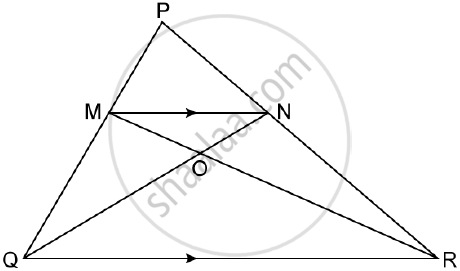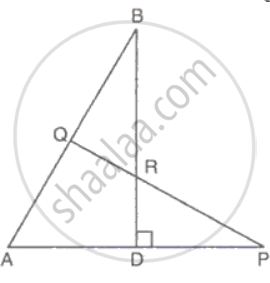Advertisements
Advertisements
प्रश्न
In ΔPQR, MN is parallel to QR and `(PM)/(MQ) = 2/3`
1) Find `(MN)/(QR)`
2) Prove that ΔOMN and ΔORQ are similar.
3) Find, Area of ΔOMN : Area of ΔORQ

उत्तर
In ΔPMN and ΔPQR, MN || QR
`=> angle PMN =anglePQR` (alternate angles)
`=> angle PNM = anglePRQ` (alternate angles)
=> ΔPMN ~ ΔPQR (AA postulate)
`= (PM)/(PQ) = (MN)/(QR)`
`=> 2/5 = (MN)/(QR) [(PM)/(MQ) = 2/3 => (PM)/(PQ) = 2/5]`
2) In ΔOMN and ΔORQ,
`angleOMN = angleORQ` (alternate angles)
`angleMNO = angleOQR` (alternate angles)
=> ΔOMN ~ ΔORQ (AA postulate)
3) `"Area of ΔOMN"/"Area of ΔORQ" = (MN)/(RQ) = 2/5`
APPEARS IN
संबंधित प्रश्न
In an isosceles ∆ABC, the base AB is produced both ways in P and Q such that AP × BQ = AC2 and CE are the altitudes. Prove that ∆ACP ~ ∆BCQ.
In ∆ABC, DE is parallel to base BC, with D on AB and E on AC. If `\frac{AD}{DB}=\frac{2}{3}` , find `\frac{BC}{DE}.`
State the SAS-similarity criterion
A triangle ABC has been enlarged by scale factor m = 2.5 to the triangle A' B' C'. Calculate : the length of C' A' if CA = 4 cm.
A triangle LMN has been reduced by scale factor 0.8 to the triangle L' M' N'. Calculate: the length of M' N', if MN = 8 cm.
ΔABC is right angled at A. AD is drawn perpendicular to BC. If AB = 8cm and AC = 6cm, calculate BD.
PQ is perpendicular to BA and BD is perpendicular to AP.PQ and BD intersect at R. Prove that ΔABD ∼ ΔAPQ and `"AB"/"AP" = "BD"/"PQ"`.
In a quadrilateral PQRS, the diagonals PR and QS intersect each other at the point T. If PT:TR = QT :TS = 1:2, show that ΔPTQ - DRTS
If figure OPRQ is a square and ∠MLN = 90°. Prove that ∆LOP ~ ∆QMO

Two similar triangles will always have ________ angles
